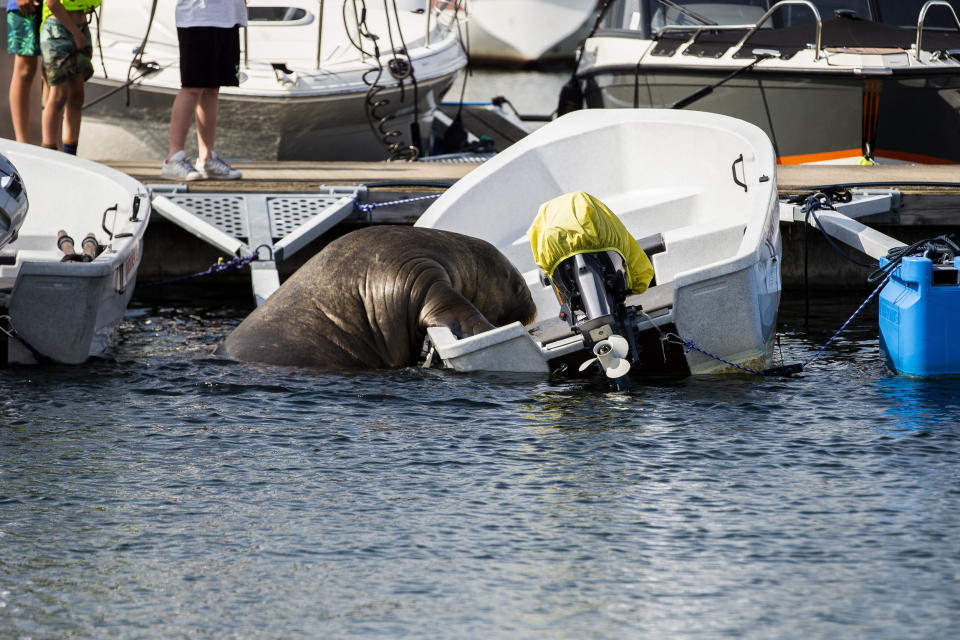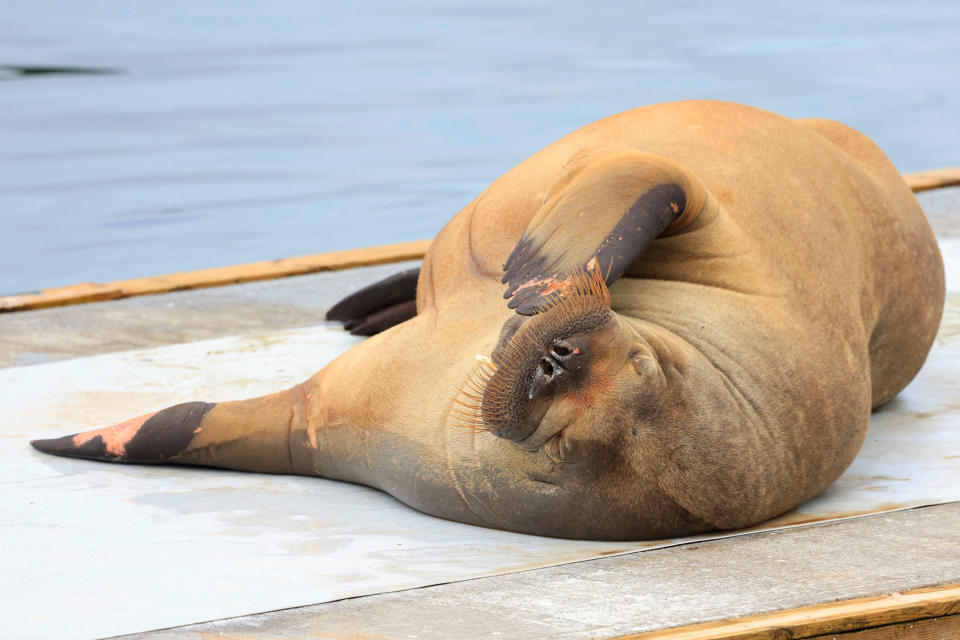Meet Freya the walrus, Norway's summer celebrity
"Where’s Freya?" That’s the question of the summer in Norway, where a young female walrus has shot to stardom by traveling the country's coastline, feeding in local harbors and crushing small boats with her hefty frame.
Norway has been enthralled for months by the marine mammal, whose celebrity status has reached such heights that she is now known only by her first name.
"Freya is back in Oslo," one local media outlet reported of the celebrity sighting. "Freya found in Snarøykilen in Bærum," another said. Updates are almost daily: "Freya is fine — Keep your distance!"

Norwegians have flocked to watch the walrus eat, sunbathe and — mostly — sleep on boats for days or weeks at a time in harbors along the country's southeastern coastline. But the boats can’t always support her weight, which Norway's Directorate of Fisheries estimates is around 1,300 pounds.
Even the sturdiest vessel tips as she clambers aboard, and her preference — rigid inflatable boats that sit low to the water and are easy to board — eventually crumple beneath her.
Walruses typically live in herds in the Arctic, so a lone walrus in the capital Oslo's busy Frognerkilen harbor — some 1,200 miles from Svalbard, where scientists believe she may be from — is an unusual sight.

Freya is choosing empty boats on which to sleep and digest her food because they remind her of Arctic ice floes, Kathrine Ryeng, a veterinary medicine scientist at Norway's Institute of Marine Research, told NBC News.
People should give Freya a wide berth and park vessels so they're harder for her to climb into, said Ryeng, who has been advising the Directorate of Fisheries on how to keep Freya, the public and their property safe. The walrus seems to be in good health and is only dangerous if you get too close, especially in the water itself.
"These animals are like potato sacks on a floating device, but like acrobats in water," she said.
While nobody has been injured by Freya's antics, she is causing a headache for emergency services and boat owners.
"We have been in contact with the insurance company, and they probably do not cover walrus damage," owner Tuva Schøyen Grue, 20, told Norwegian broadcaster TV 2 after Freya's encounter with her inflatable boat in the city of Stabbestad.
Despite the material damage Freya has caused so far, as a protected species in Norway, “euthanasia is out of the question,” the Directorate of Fisheries said in a statement Tuesday, when Freya returned to Oslo after a few days east.
Although not ruling out relocating her if “the situation worsens,” the directorate is encouraging Norwegians to “be considerate and keep their distance.”
Freya's fame may have peaked this summer, but she has been spotted as early as 2019, said Rune Aae, a doctoral student in science didactics at the University of South-Eastern Norway. Aae has mapped Freya's journey through photos uploaded by scientists and amateur photographers to online databases and social media.
According to Aae's map of sightings, Freya has visited the coasts of Sweden, Denmark, England, Germany, the Netherlands and the Shetland Islands in the last three years.
Her small tusks, white scar on her right nostril and previous injury on her flipper allow Aae to distinguish between Freya and previous sightings of fellow celebrity walruses Wally and Stena, who embarked on their own European tours for several years before returning to the Arctic to settle down.

"It appears to be the same animal that travels for a year and a half," Aae said. "She will go back like Wally did."
As climate change causes ice cover in the Arctic to melt, more walruses are hunting on land, creating competition for food that may explain why Freya has traveled so far.
Her journey seems to overlap with coastal areas of northern Europe that have become home to an invasive species of Pacific oyster, Ryeng said. Walruses can eat thousands of oysters in one meal, so if Freya has developed a taste for them, her culinary tour could prove environmentally "helpful," she added.
In the northeastern Atlantic, walruses are native to East Greenland and Arctic archipelagos like Svalbard and Franz Josef, down to the southern Barents and Kara seas. After centuries of being hunted for their tusks, blubber and meat, they are an endangered species in Norway.
A 2018 count found that efforts to protect the walrus had been successful, with a growing population of around 5,500 living on Svalbard, from a low of just 100 in 1980.

